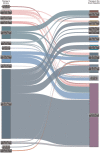HIV-positive Ukrainian refugees in the Czech Republic
- PMID: 37352491
- PMCID: PMC10481916
- DOI: 10.1097/QAD.0000000000003633
HIV-positive Ukrainian refugees in the Czech Republic
Abstract
Objective: Over 480 000 Ukrainian refugees have arrived in the Czech Republic since the Russian invasion of Ukraine in 2022, including over 500 people with HIV. This study describes the demographics, characteristics, and management of Ukrainian refugees with HIV in the Czech Republic.
Design: Retrospective, observational, noninterventional study.
Methods: Ukrainian nationals registering at HIV centers in the Czech Republic with war refugee status were included. Data were collected from medical records between 1 March and 31 July 2022. The study was registered with the Czech State Institute for Drug Control, ID number 2301200000.
Results: Four hundred and eighty-two patients were included in the study. Most patients were female (69.5%; n = 335/482) with well-controlled HIV. The median [interquartile range] CD4 + cell count was 597 [397] cells/μl of blood, and 79.3% ( n = 361/455) of patients had HIV RNA <40 copies/ml. Coinfections of hepatitis C virus, hepatitis B virus, and/or tuberculosis were reported for 17.4% ( n = 78/449), 9% ( n = 40/446) and 1.3% ( n = 6/446) of patients, respectively. In Ukraine, 85.7% ( n = 384/448) of patients had been receiving an integrase strand transfer inhibitor-based regimen and most (69.7%; n = 310/445) did not switch therapy upon arrival in the Czech Republic.
Conclusion: Migration from Ukraine is changing the characteristics of HIV epidemiology in the Czech Republic. Ukrainian refugees with HIV have been provided with a high standard of medical care in the Czech Republic. Improved coordination between medical services within the Czech Republic and between countries in the European Union is necessary to optimize patient care.
Copyright © 2023 The Author(s). Published by Wolters Kluwer Health, Inc.
Conflict of interest statement
R.M., D.J., D.B., Z.B., J.C., A.C., P.D., S.C., S.G.d.S., J.K., M.K., S.S., R.S., M.Z., O.S., and D.S. report no conflict of interest related to this study.
T.G. is an employee of Gilead Sciences.
Data availability: The datasets used and/or analyzed during the current study are available from the corresponding author on reasonable request:
Figures
References
-
- United Nations High Commissioner for Refugees (UNHCR). Ukraine refugee situation. 2022. Available at: https://data.unhcr.org/en/situations/ukraine [Accessed 14 December 2022].
-
- United Nations High Commissioner for Refugees (UNHCR). Ukraine situation: Czech Republic: inter-agency operational update (March–June 2022). 2022. Available at: https://data.unhcr.org/en/documents/details/94220 [Accessed 16 December 2022].
-
- European Centre for Disease Prevention and Control (ECDC). Operational considerations for the provision of the HIV continuum of care for refugees from Ukraine in the EU/EEA. 2022. Available at: https://www.ecdc.europa.eu/en/publications-data/operational-consideratio... [Accessed 14 December 2022].
-
- The Council of the European Union. Council Implementing Decision (EU) 2022/382 of 4 March 2022 on establishing the existence of a mass influx of displaced persons from Ukraine within the meaning of Article 5 of Directive 2001/55/EC, and having the effect of introducing temporary protection. Brussels: Official Journal of the European Union. 2022. Available at: https://eur-lex.europa.eu/legal-content/EN/TXT/?uri=uriserv%3AOJ.L_.2022... [Accessed 14 December 2022].
-
- UNAIDS. Country factsheets Ukraine 2021. Available at: https://www.unaids.org/en/regionscountries/countries/ukraine [Accessed 16 December 2022].
Publication types
MeSH terms
LinkOut - more resources
Full Text Sources
Medical
Research Materials



